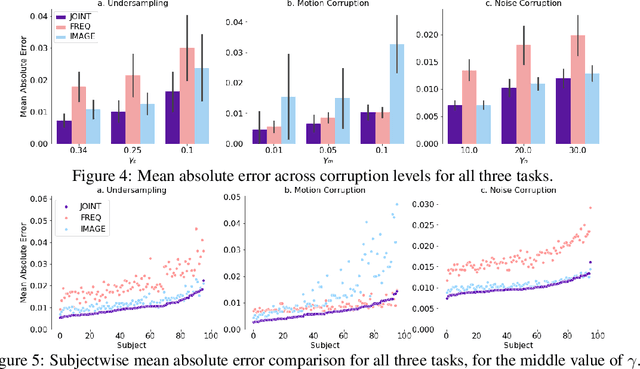Nalini M. Singh
Estimation-theoretic analysis of lensless imaging
Jan 24, 2025


Abstract:We analyze lensless imaging systems with estimation-theoretic techniques based on Fisher information. Our analysis evaluates multiple optical encoder designs on objects with varying sparsity, in the context of both Gaussian and Poisson noise models. Our simulations verify that lensless imaging system performance is object-dependent and highlight tradeoffs between encoder multiplexing and object sparsity, showing quantitatively that sparse objects tolerate higher levels of multiplexing than dense objects. Insights from our analysis promise to inform and improve optical encoder designs for lensless imaging.
Data Consistent Deep Rigid MRI Motion Correction
Jan 25, 2023



Abstract:Motion artifacts are a pervasive problem in MRI, leading to misdiagnosis or mischaracterization in population-level imaging studies. Current retrospective rigid intra-slice motion correction techniques jointly optimize estimates of the image and the motion parameters. In this paper, we use a deep network to reduce the joint image-motion parameter search to a search over rigid motion parameters alone. Our network produces a reconstruction as a function of two inputs: corrupted k-space data and motion parameters. We train the network using simulated, motion-corrupted k-space data generated from known motion parameters. At test-time, we estimate unknown motion parameters by minimizing a data consistency loss between the motion parameters, the network-based image reconstruction given those parameters, and the acquired measurements. Intra-slice motion correction experiments on simulated and realistic 2D fast spin echo brain MRI achieve high reconstruction fidelity while retaining the benefits of explicit data consistency-based optimization. Our code is publicly available at https://www.github.com/nalinimsingh/neuroMoCo.
Joint Frequency- and Image-Space Learning for Fourier Imaging
Jul 02, 2020



Abstract:We propose a neural network layer structure that combines frequency and image feature representations for robust Fourier image reconstruction. Our work is motivated by the challenges in magnetic resonance imaging (MRI) where the acquired signal is a corrupted Fourier transform of the desired image. The proposed layer structure enables both correction of artifacts native to the frequency-space and manipulation of image-space representations to reconstruct coherent image structures. This is in contrast to the current deep learning approaches for image reconstruction that manipulate data solely in the frequency-space or solely in the image-space. We demonstrate the advantages of the proposed joint learning on three diverse tasks including image reconstruction from undersampled acquisitions, motion correction, and image denoising in brain MRI. Unlike purely image based and purely frequency based architectures, the proposed joint model produces consistently high quality output images. The resulting joint frequency- and image-space feature representations promise to significantly improve modeling and reconstruction of images acquired in the frequency-space. Our code is available at https://github.com/nalinimsingh/interlacer.
 Add to Chrome
Add to Chrome Add to Firefox
Add to Firefox Add to Edge
Add to Edge